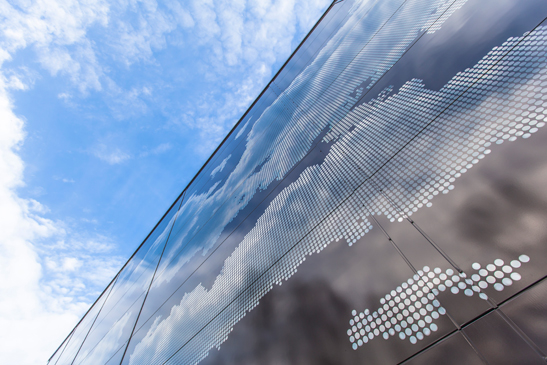The first near zero-energy hall in Finland for commercial and office premises has been completed at Häme University of Applied Sciences (HAMK) in Hämeenlinna. Built for R&D and teaching use, the new hall will be occupied by HAMK and Ruukki Construction. The hall was built to show that it is economically viable to build a near zero-energy building even in northern climes.
”To our knowledge, the hall that has just been completed is the only one of its kind in the world. A new way of building results in energy-efficient, high quality comfortable buildings that save the financial resources of their owners. This building features a number of energy-producing and energy-saving solutions, including airtight wall panels and a roof and wall harnessing the solar energy. Product development at Ruukki is increasingly geared towards buildings that deliver greater benefit to their occupants,” says Marko Somerma, Head of Ruukki Construction.

”The new building is home to the Sheet Steel Centre, which was established in 1998 and is HAMK’s oldest research unit. The building is part of an extensive campus restructuring, with the creation of the largest university of applied sciences-based cluster innovation in Finland in HAMK’s University Centre,” says Pertti Puusaari, Rector of HAMK.
“Research and development activities are geared towards improving the competitiveness of the products and production of the Finnish sheet steel and metal industry. Research and development is carried out in collaboration with industry and other research bodies, with a focus on the following competences: material durability and coatings, sheet metal product manufacturing techniques, steel structures and their structural testing and also the behaviour of structures in heat and moisture,” explains Jarmo Havula, director of the Sheet Metal Centre.
The main departure point in building the hall was to create a building that both saves energy and utilises renewable energy. The successful outcome of the building is that it was designed as a whole rather than being split up into various parts. Optimisation gave the best end result over the entire lifetime of the building. In this context, optimisation means investment outlay, additional costs during the use of the building and the potential savings were taken into account when choosing the solutions used. In other words, energy savings and generation were examined over the entire lifetime of the building. For example, it is not worth using thicker insulation in the roof and walls where a higher return can be gained by using renewable energy.
Overview of the solutions used in the new building
Solar power from the roof and walls
Ruukki Classic solar roof collects solar heat, which is conducted through energy piles into the ground. The heat stored in this way is used to heat the building during the winter.
The building façade features the Ruukki® on-wall solar system, which converts the sun’s rays into energy for the building.
Lighting
The glass windows on the south-facing side of the building have been replaced by polycarbonate daylight windows, through which incoming light does not glare. These windows also insulate heat well and so prevent the sun’s thermal rays from heating the premises in summer.
Airtight wall structures
The airtight outside walls have been created using energy panels, which save heating costs. This in turn reduces lifecycle costs and carbon dioxide emissions.
Heating and cooling from the roof
Ruukki’s heating and cooling profiles based on solar radiation have been affixed to the underside of the ceiling. These cut the energy consumption used in air-conditioning and reduce temperature variations on each floor.
Impressive façades
Ruukki Expression and Ruukki Forma products add to the impressive looks of the building. Expression enables any photographic image to be taped on to a façade, in this case a cloudy sky. Forma enables façade cladding products to be affixed to panels to give buildings a more multi-dimensional look. In this case, Cor-Ten rainscreen panels have been used.
Building churning out data
Instruments and censors have been installed in the building structures to measure the functioning of the building’s structures and mechanical and electrical solutions, and to verify energy efficiency. The data generated will be used by adjusting the building to work as planned.
Truong Duy
